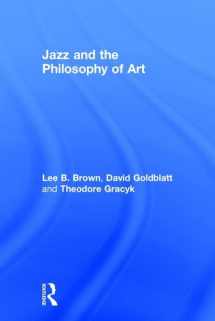
Jazz and the Philosophy of Art
ISBN-13:
9781138241350
ISBN-10:
1138241350
Edition:
1
Author:
David Goldblatt, Lee B. Brown, Theodore Gracyk
Publication date:
2018
Publisher:
Routledge
Format:
Hardcover
302 pages
FREE US shipping
Book details
ISBN-13:
9781138241350
ISBN-10:
1138241350
Edition:
1
Author:
David Goldblatt, Lee B. Brown, Theodore Gracyk
Publication date:
2018
Publisher:
Routledge
Format:
Hardcover
302 pages
Summary
Jazz and the Philosophy of Art (ISBN-13: 9781138241350 and ISBN-10: 1138241350), written by authors
David Goldblatt, Lee B. Brown, Theodore Gracyk, was published by Routledge in 2018.
With an overall rating of 3.8 stars, it's a notable title among other
books. You can easily purchase or rent Jazz and the Philosophy of Art (Hardcover) from BooksRun,
along with many other new and used
books
and textbooks.
And, if you're looking to sell your copy, our current buyback offer is $0.48.
Description
Co-authored by three prominent philosophers of art, Jazz and the Philosophy of Art is the first book in English to be exclusively devoted to philosophical issues in jazz. It covers such diverse topics as minstrelsy, bebop, Voodoo, social and tap dancing, parades, phonography, musical forgeries, and jazz singing, as well as Goodman’s allographic/autographic distinction, Adorno’s critique of popular music, and what improvisation is and is not. The book is organized into three parts. Drawing on innovative strategies adopted to address challenges that arise for the project of defining art, Part I shows how historical definitions of art provide a blueprint for a historical definition of jazz. Part II extends the book’s commitment to social-historical contextualism by exploring distinctive ways that jazz has shaped, and been shaped by, American culture. It uses the lens of jazz vocals to provide perspective on racial issues previously unaddressed in the work. It then examines the broader premise that jazz was a socially progressive force in American popular culture. Part III concentrates on a topic that has entered into the arguments of each of the previous chapters: what is jazz improvisation? It outlines a pluralistic framework in which distinctive performance intentions distinguish distinctive kinds of jazz improvisation. This book is a comprehensive and valuable resource for any reader interested in the intersections between jazz and philosophy.


We would LOVE it if you could help us and other readers by reviewing the book
Book review

Congratulations! We have received your book review.
{user}
{createdAt}
by {truncated_author}


